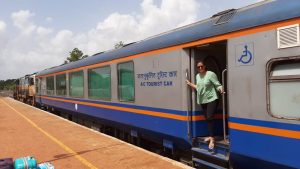
Train Waiting List Ticket Confirmation Chances
India’s railway reservation system is one of the largest and most intricate in the world, and the waiting list mechanism plays a crucial role in it. With millions of passengers booking tickets daily, the Indian Railways uses a reservation system that assigns a waiting list position when no confirmed seats are available at the time of booking. Different types of waiting lists offer varying chances of confirmation, each governed by distinct factors and rules. This article delves into the major waiting list categories: RAC, GNWL, RLWL, PQWL, and TQWL, offering insights into the confirmation likelihood of each type and guidance on which lists are most likely to be confirmed.
- Reservation Against Cancellation (RAC)
RAC tickets are essentially a middle ground between confirmed tickets and standard waiting list tickets. When a passenger holds an RAC ticket, they have a partially confirmed seat. RAC passengers are allocated a seat on the train but are expected to share it with another RAC passenger until one of them receives a full berth upgrade, which occurs if confirmed passengers cancel their bookings. Key points about RAC:
Confirmation Chances: RAC tickets have a relatively high chance of being confirmed compared to other waiting list types. As cancellations occur, RAC ticket holders are upgraded from half-seats to full berths.
Splitting the Seat: Until the seat is fully confirmed, two RAC passengers may need to share one seat.
Why RAC is Better for Urgent Travel: Even if the ticket is not fully confirmed, an RAC ticket ensures you board the train and at least have a shared seat. Therefore, RAC tickets are favorable for those who want to secure travel.
Factors Influencing RAC Confirmation
Cancellation Rate: As confirmed ticket holders cancel, RAC ticket holders are assigned their seats.
Availability of Upper-Class Seats: Sometimes, RAC passengers get upgraded to upper classes if seats become vacant.
Train and Route Popularity: Popular routes, such as those on busy metropolitan lines, often see lower RAC confirmations as they have more demand and fewer cancellations.
- General Waiting List (GNWL)
The General Waiting List (GNWL) is the most common type of waiting list in Indian Railways. GNWL is assigned to passengers who book from the originating station or nearby stations on the route. GNWL tickets have the highest priority among waiting list categories for confirmation when a seat opens up due to a cancellation.
Confirmation Chances: GNWL has a high confirmation probability compared to other types like RLWL, PQWL, and TQWL. Seats released through cancellations are usually first offered to GNWL passengers.
Flexibility of Route: Since GNWL applies to the originating and nearby stations, it has a broader chance of confirmation compared to route-specific waiting lists like RLWL.
Factors Influencing GNWL Confirmation
Train Class and Frequency of Cancellations: Trains with high demand often experience high cancellations, which can improve the chances for GNWL ticket holders.
Route Demand: GNWL for popular routes has a better chance of confirmation since more passengers book and cancel tickets along these routes.
- Remote Location Waiting List (RLWL)
The Remote Location Waiting List (RLWL) is assigned to passengers booking from intermediate or remote stations rather than the origin or destination station. RLWL applies when the boarding point lies between the train’s originating and terminating stations. RLWL tickets generally have a lower chance of confirmation than GNWL.
Confirmation Chances: RLWL tickets have lower priority than GNWL tickets. Only if seats remain after GNWL are RLWL tickets considered for confirmation.
Higher Risk of Non-Confirmation: RLWL is less likely to be confirmed since GNWL passengers have priority for vacant seats, and there are typically fewer cancellations for intermediate stops.
Factors Influencing RLWL Confirmation
Train Class and Route: Long-distance trains with multiple stops tend to have more RLWL requests.
Cancellations at Intermediate Stations: Passengers boarding at intermediate stations may cancel, which could free up seats for RLWL passengers, but GNWL usually takes precedence.
- Pooled Quota Waiting List (PQWL)
The Pooled Quota Waiting List (PQWL) is applied to passengers traveling between two intermediate stations on the train’s route, rather than from the origin or destination. Pooled Quota is designated for certain smaller sections along the route where the passenger flow is generally lower.
Confirmation Chances: PQWL tickets have a moderate chance of confirmation, with lower priority than GNWL but sometimes higher than RLWL and TQWL, depending on train and route dynamics.
Limited Seats: Since PQWL applies to specific sections, the availability and chance of confirmation vary significantly by the popularity and distance between the intermediate stops.
Factors Influencing PQWL Confirmation
Short-Distance Travel: PQWL is often easier to confirm on less crowded sections of the route where passenger demand is lower.
Quotas on Different Routes: Trains that carry a lower passenger load on specific sections may confirm PQWL tickets more readily.
- Tatkal Quota Waiting List (TQWL)
The Tatkal Quota Waiting List (TQWL) is assigned to passengers booking last-minute tickets through the Tatkal system. Tatkal tickets are intended for urgent travel, where the bookings open just one day before the train’s departure. TQWL applies if Tatkal tickets are unavailable, placing passengers on a separate waiting list. TQWL tickets usually have the lowest chance of confirmation.
Confirmation Chances: TQWL is the least likely to be confirmed among waiting list types since GNWL, RLWL, and RAC have priority.
Priority in Confirmation: Confirmed Tatkal tickets take precedence over TQWL, and cancellations rarely occur in Tatkal quota seats.
Factors Influencing TQWL Confirmation
Demand for Tatkal Seats: As TQWL serves emergency or last-minute bookings, the availability of seats is generally scarce.
Cancellation Patterns: Because Tatkal tickets are booked close to departure, passengers rarely cancel, further lowering TQWL confirmation chances.
Which Waiting List Gets Confirmed First?
To summarize, different waiting lists have varying priorities in Indian Railways, with confirmation rates influenced by factors like cancellation rates, booking origin, and route demand. Here’s an order of priority for confirmation among waiting lists:
RAC (First to Confirm): RAC tickets offer partial seat allocation and have the highest chance of confirmation through seat upgrade. Even if not upgraded, RAC holders can still travel.
GNWL (Second in Priority): Passengers holding GNWL tickets are prioritized after RAC, especially if they book from the origin or near-origin stations.
PQWL (Moderate Priority): For passengers traveling between two intermediate stations, PQWL confirmation depends on specific route dynamics.
RLWL (Lower Priority): Since RLWL applies to passengers boarding at intermediate stops, it’s less likely to confirm due to GNWL’s higher precedence.
TQWL (Lowest Priority): TQWL holds the lowest priority in the waiting list hierarchy, with minimal chances of confirmation.
Tips for Increasing Chances of Ticket Confirmation
Book Early: Book your ticket as early as possible to avoid ending up on the waiting list.
Choose GNWL Over RLWL and PQWL: When booking, select the originating station or a station nearby to increase your chances of being assigned GNWL.
Monitor Status Frequently: Check your PNR status regularly. Knowing your updated status helps make alternative travel arrangements if confirmation seems unlikely.
Opt for RAC if Available: If you’re placed on the RAC list, you have a higher chance of at least obtaining a seat. Consider RAC bookings, especially if your journey is crucial.
Tatkal as a Last Resort: Use Tatkal only for emergencies, as TQWL has the lowest chance of confirmation.
Understanding the structure and priority order of the Indian Railway’s waiting list system can significantly enhance your travel planning experience. By familiarizing yourself with the different types of waiting lists—RAC, GNWL, RLWL, PQWL, and TQWL—you can make informed booking decisions that improve your chances of securing a confirmed seat. Whether you’re booking in advance or through Tatkal, knowing how each waiting list functions will help you gauge the likelihood of confirmation and arrange your travel plans accordingly.

Leave a Reply